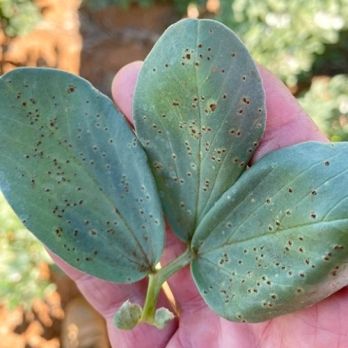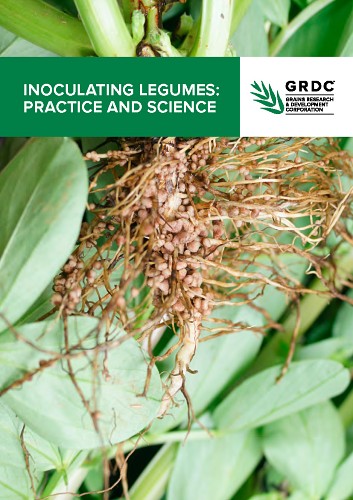Crop Watch August (no. 2) 2022

Rust on faba beans
Rust on faba beans has been reported on the lower Eyre Peninsula and Upper North this season. All southern faba bean varieties are rated VS or S except for PBA Marne which is rated MRMS.
Conditions favourable for rust developing include regions or seasons where there is high prolonged humidity, warmer temperatures and where crops are sown early. Rust spores are spread by wind and rain splash, and infested faba bean stubble from the previous year provide a source of inoculum.
Rust on faba beans is not usually an issue in the southern region, partly owing to the cold winter that shortens conditions favouring rust development in the growing season. This contrasts with northern Australia (NSW) where it is often a problem due to long periods of warm, humid conditions. Additionally, in the southern region disease management strategies that include a spray around 4–6 weeks after sowing usually reduce inoculum levels below levels of concern if rust is present in this cooler part of the year. A fungicide application may be required now if rust is present and rain is forecast.
There are several products registered for control of rust on faba beans and growers are recommended to monitor crops and apply a spray ahead of rainfall if rust is present.
More information is available on the Pulse Australia website.
Got a pulse? Check your nodules
August is the perfect time to check pulse root nodulation.
Rhizobia are bacteria which form nodules on legume roots, where nitrogen from the atmosphere is converted to a plant-available form.
Roots of crop and pasture legumes need to have adequate numbers of root nodules to ensure optimal nitrogren fixation.
Nodules can form from soil rhizobia or through inoculation.
It is helpful to assess root nodulation, irrespective of whether the seed was inoculated or not to help inform future practices.
Conduct 'nodulation checks' in the time window between 10–12 weeks after emergence.
For more information see page 43 of Inoculating Legumes: Practice and Science (PDF 7.7 MB)
Don’t forget about cereal cyst nematode
The threat from cereal cyst nematode (CCN), Heterodera avenae, still exists despite resistant cereal varieties and non-host crop rotations controlling this pest in the past. It’s important that growers remain vigilant as some of the newer wheat varieties that are MSS and S are again increasing population levels.
In 2022, 20% of SA paddocks tested by PREDICTA B (100 paddocks) had CCN.
All growers, but particularly those planting CCN-susceptible cereals, should monitor numbers in their paddock as densities can increase rapidly in one season under a susceptible variety.
Check the Cereal Variety Disease Guide 2022 () for varietal resistance ratings.
Assess CCN risk using a pre sow PREDICTA B soil test or assess plant/soil samples during Spring when the cysts become visible on the roots of affected plants.
Send us your pulse, canola and cereal crop disease samples
SARDI is seeking diseased samples from this year's commercial pulse, canola, barley and oat crops to assist with our research.
The samples will assist research scientists Sara Blake and Tara Garrard with monitoring the nature and extent of disease in 2022.
Grain growers and advisers are being asked to help in providing samples of:
- ascochyta blight in lentil, faba bean and chickpea
- sclerotinia in pulse and canola crops
- net form net blotch and scald in barley
- septoria in oats.
These samples will contribute to GRDC project investments that screen for any changes in ascochyta blight disease resistance of current cultivars, to monitor pathogen population changes and to also understand how serious a disease sclerotinia is for the southern pulse industry.
The barley disease samples will contribute to a national GRDC survey pathotyping key barley foliar pathogens to monitor pathogen population changes and to screen for any disease resistance changes.
Oat septoria samples will contribute to a GRDC project identifying novel sources of oat septoria resistance and understanding the virulence of the pathogen.
For ascochyta and sclerotinia in pulses and canola, collection kits with return envelopes will be provided to growers and advisers willing to provide samples. Contact:
Sara Blake
Phone: (08) 8429 2248
Email: sara.blake@sa.gov.au
For net form net blotch and scald in barley, and Septoria in oats, contact:
Tara Garrard
Phone: (08) 8429 2247
Email: tara.garrard@sa.gov.au
Stay up to date with the latest disease-related issues and solutions for broadacre crops during the growing season.




